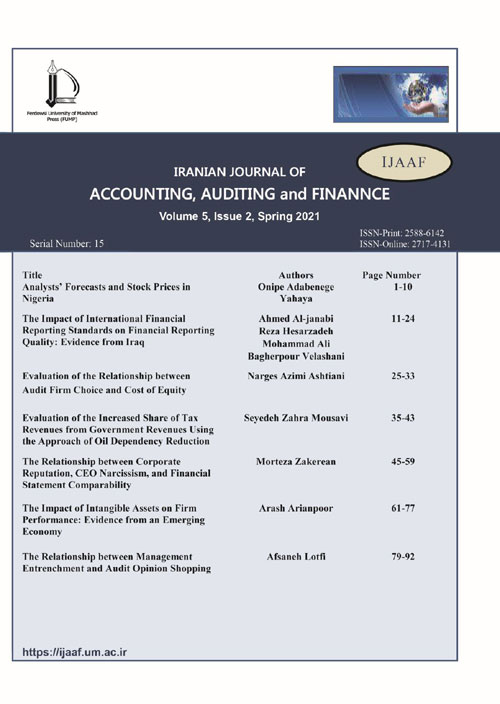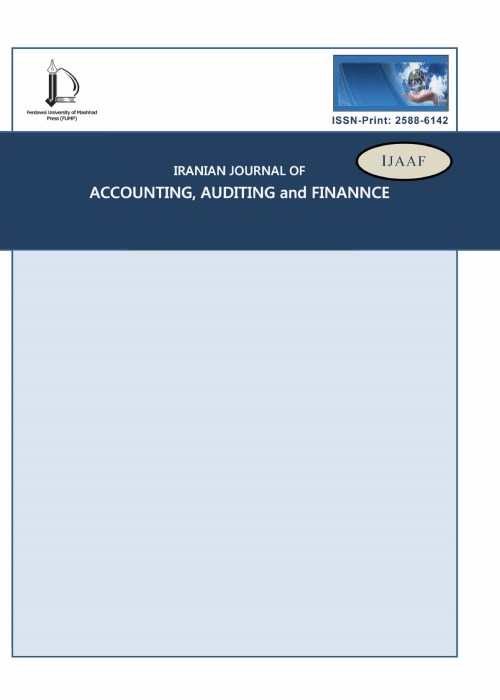فهرست مطالب

Iranian Journal of Accounting, Auditing and Finance
Volume:1 Issue: 1, Winter 2017
- تاریخ انتشار: 1399/05/15
- تعداد عناوین: 7
-
Pages 1-18
The present study investigates the mediating effect of the dividend policy on the relationship between corporate governance quality and informative income smoothing. Tucker and Zarowin (TZ) and Albrecht and Richardson (AR) approaches are utilized as the proxies of informative income smoothing. In addition, the accumulated coding method and dividend are applied to measure the corporate governance quality and dividend policy respectively. By applying a systematic elimination method, 109 firms remained as the final sample for the period from 2007 to 2014. Using the TZ method, we found that there is a significant and positive relationship between corporate governance quality and informative income smoothing. Finally, according to the results of Sobel’s Test, the role of dividend policy as a mediating variable was not verified in the relationship between corporate governance quality and informative corporate governance (TZ); however, if the AR method is used for measuring informative income smoothing, the dividend policy may mediate the relationship between corporate governance quality and informative income smoothing.
Keywords: Dividend policy, informative income smoothing, informativeincome smoothing, quality of corporate governance -
Pages 19-38
This study investigated the effect of auditor's type and expertise on real activities manipulation and compared it with accrual-based earnings management within the framework of fraud triangle concepts (opportunity, pressure, and rationalization). The research statistical population consists of all companies listed on Tehran Stock Exchange during 2001-2015. According to the literature review, the earnings manipulation is conducted through methods such as offering sales discounts, facilitation of credit sales opportunities, overproduction, and reduced discretionary expenditure. Based on the theoretical literature, companies with a low return (first level after zero earnings) were selected as the companies exposed to earnings manipulation, and accordingly, the levels of accrual and real earnings manipulation in this group of companies were measured. The estimation results indicated high levels of abnormal accrual and real activities in companies exposed to the earnings management. Having employed the earnings manipulation proxies, we examined the impact of auditor's type and expertise on reducing the level of real activities and discretionary accruals at two levels, including all companies listed on stock exchange and companies exposed to earnings manipulation. The results of hypothesis testing indicated a significant and positive relationship between auditor's type and earnings manipulation level through real activities.
Keywords: Earnings manipulation, real earnings management, accrualbased earnings management, auditor's type, auditor's expertise -
Pages 39-51
The purpose of the current study is to investigate the relationship between tax avoidance and asymmetric costs. Generally, shareholders expect managers to pursue their personal interests, so they attempt to reduce tax liabilities and tax avoidance because of the additional benefits of reducing contingent liabilities are more than the expected additional costs. Managers of a company often face issues such as planning and control of the business. In the planning stage, managers need costs information to predict future costs. Since changes in future costs can be determined based on the sales revenue changes, the amount of spending and costs can be predicted based on their relations with this factor. The results of hypotheses testing of 112 listed companies on the Tehran Stock Exchange during 2006-2015 showed that tax avoidance has a positive and significant relationship with the costs changes at the time of falling sales. In addition, when there is a fluctuation in cash flows, tax avoidance has a negative and significant relationship with costs changes.
Keywords: Tax avoidance, Tax, Cost behavior, Cost stickiness -
Pages 53-66
The aim of this study is to investigate the relationship between financing constraints and the cost of equity of listed companies on the Tehran Stock Exchange during 2010-2014. The results showed that the impact of cash flows on the company's cash balance changes in both groups of companies with/without the divergence in the right to control. In other words, financing constraint is significant on the financial supply of both companies. By comparing the impact factors of these variations, we observed that the control right divergence of controlling shareholder leads to increased financing constraints. The results also indicated that the divergence of the control right of shareholders from the right to control cash flow can lead to an increased cost of equity.
Keywords: Financing constraints, Right to Control, Cost of Equity -
Pages 67-81
This study examines the effects of intellectual capital components on the investment decision indicators. Decision-making process of investors is influenced by a combination of financial and non-financial information. The purpose of this study is to introduce variables that investors take into account in the decision model to achieve a better efficiency. Our sample consists of 120 publicly listed companies on the Tehran Stock Exchange operating in eight industries over a five-year period (2011-2015). We use the estimated generalized least squares method in the present study. The results show a significant and positive impact of the components of intellectual capital on stock liquidity, earnings per share, stock returns, and stock price volatility. However, there is no statistically significant relationship between the components of intellectual capital and price to earnings ratio as well as dividends per share. Overall, the present paper indicates the different components of intellectual and capital-based indicators of investment decisions in various industries.
Keywords: Intellectual capital, Human capital, Capital employed, Structuralcapital, Economic value added -
Pages 83-96
The present study examines and models factors influencing the use of environmental management accounting tools from the financial managers and their assistants’ point of view in the Iranian oil refineries and petrochemical companies. For the purpose of the study, five hypotheses were developed and tested using the models of structural equations. The required data were also collected by a questionnaire. According to the financial managers and based on their assistants’ point of view, limited resources and lack of financial support, specialist human resources, knowledge, support of management, the complexity of the tools, and the ability to create comparative advantages are the factors affecting the use of environmental management accounting tools. The findings of the fifth hypothesis also show that except sex, all of the personal characteristics of financial managers and financial managers’ assistants, such as professional experience, field of study, academic qualification, and age have a significant impact on some effective factors in using the environmental management accounting tools.
Keywords: environmental management accounting, oil refinery andpetrochemical companies, structural equation models -
Pages 97-121
This study examines audit pricing in an emerging audit market characterized by increasing competition but segmented by the continued presence of a government audit firm, and the exclusion of international audit firms. Using traditional audit fee modeling, we find that: (1) despite the absence of international “brand names”, audit firm size or market power remains associated with audit fee premium; (2) companies precluded from switching to a private sector pay a fee premium to the quasi-monopolistic audit firm. This study extends the audit pricing literature by identifying the extent of discretionary pricing relative to variations in auditor competition.
Keywords: Audit fees, Audit fee premium, Auditor competition


